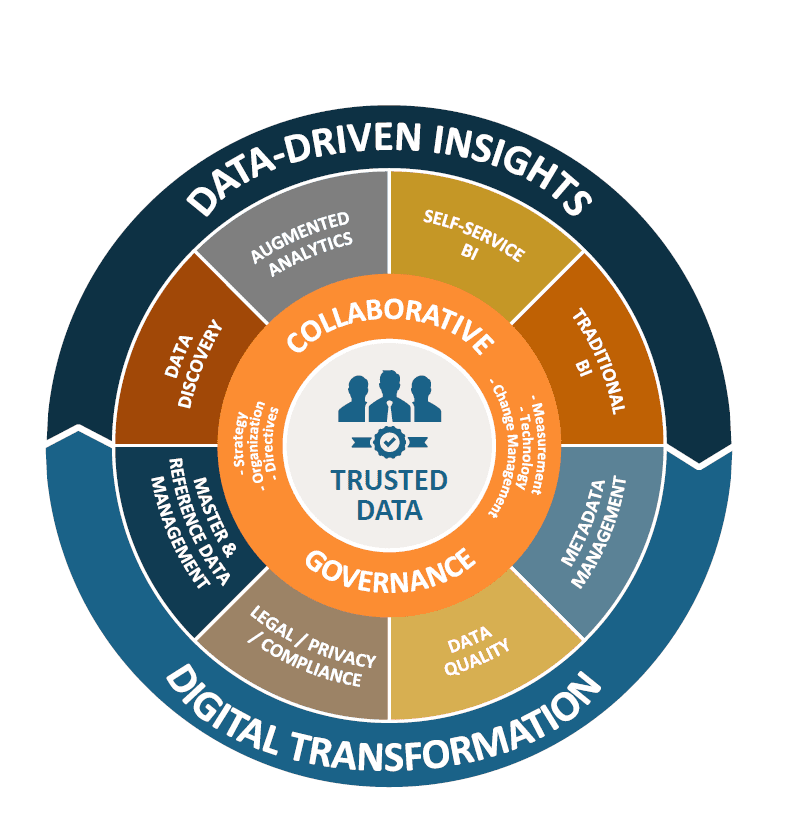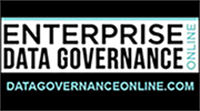
Companies were engaged in Data Governance practices such as Data Lineage and Data Quality for years before the concept of Data Governance emerged as a mainstream enterprise-level activity in 2005, said Kelle O’Neal, the founder and CEO of First San Francisco Partners, during her DATAVERSITY® Enterprise Data Governance Online event presentation titled Data Governance 2.0.
Driven by an awareness that survival meant that data should be at the heart of their business, executives realized their data was not up to the task. Business semantics support emerged in 2008, then cloud migration in 2012, data lakes in 2013, followed by data wrangling in 2014, she said. By 2015, self-service analytics and data privacy were key concerns. “Governance became a practice in and of itself, and companies realized that there’s value in being more organized around Governance,” said O’Neal.
A Vision of Modern Data Governance
O’Neal presented a graphic representing modern Data Governance, where trusted data is at the center of a wheel surrounded by collaborative governance. Key governance concepts such as Metadata Management and Data Quality are spokes in the wheel, and data-driven insights and digital transformation are on the outside of the wheel.

Race Toward Digital Transformation
In a 2018 white paper by IDG entitled State of Digital Business Transformation, researchers noted that 89 percent of organizations have adopted — or had plans to adopt — a digital‐first strategy, yet only 44 percent had fully adopted this approach. A 2016 survey done by Progress found that 86 percent of enterprise decision makers felt they had a timeframe of just two years to make significant inroads on digital transformation before suffering financially or falling behind their competitors, said O’Neal. The top drivers for digital transformation are improved customer experience, increased innovation speed, and improved time-to-market.
Trends in Data Governance Create Pressure
O’Neal identified four key trends in Data Governance creating pressure for data-driven change:
- The demandfor rapid time-to-insight is creating a need for governance to ensure that data is understood, trusted, and appropriately used. “Speed of insight is really critical.”
- General Data Protection Regulation (GDPR) and other new and emerging data privacy regulations are driving compliance and a focus on consumer protection. Recent fines levied on companies such as Google are an indication that “Regulators are very serious and this is going to result in financial implications.”
- The rise and expansion of the role of the Chief Data Officer (CDO) is bringing data into the C-suite, and evangelizing the value of Data Quality and data-driven decision-making.
- The evolution of Data Governance scope and adoption across the enterprise is driving a demand for focused tools and supporting technology. Data Governance as a practice is now driving innovation as well as new technology creation and investment, she said.
To respond to these trends, O’Neal offered six different areas where companies can “ride the wave,” and thus deal effectively with the pressures they present.
Ride the Wave: Expanding the Scope of Data Governance
O’Neal suggested building upon existing Data Governance practices by assessing what has worked and what hasn’t worked, using both as a learning opportunity. Identify what can be reused and what needs to be adjusted and improved, with a focus on incremental growth rather than big leaps.
For example, it’s very difficult to be able to capture 100 percent of metadata or 100 percent of lineage, she said, “So focus on what provides the business value, how you can get started with a kernel, and then how you can incrementally expand that kernel of knowledge around your data so that it can be reused.” She emphasized that Data Governance should now be considered an operational capability, rather than just a program. This shift in mindset changes the perspective of Data Governance from a focus on providing guidelines and directives, to “providing support as close as possible to the point of usage.”
Lastly, it’s important not just to measure the expansion of Data Governance, but how that expansion is delivering value back to the organization, she said:
“Governance really needs to demonstrate value beyond regulatory requirements, beyond structured data, to really show business value from data as a broader capability.”
Ride the Wave: Ensuring Representation and Accountability for Modern Data Governance
With the expansion of Data Governance across broader geographies, across more lines of business, and more types of data, the scope of Data Governance has changed, and the view of representation and accountability also needs to change with it. “It’s important that you’re considering who is accountable for all types of data,” as well as which teams and individuals should be represented in Governance.
There are some tradeoffs, however, when bringing more representation into the governance process. “Sometimes with greater representation, speed of execution slows down,” which can affectthe pace of change, while the demand for speed is increasing all the time. Proactive organizational change management can help identify how the new governance practices fit in with existing operational processes, she said, so that Data Governance is integrated into those business processes, not isolated from them.
Ride the Wave: Prioritizing Effort for Key Business Objectives
Map governance to corporate vision and critical objectives so that activities are prioritized based on business need and strategic importance, “Not just who is screaming the loudest.” Engage with the project management organization to leverage resources needed to deliver on governance expectations. Determine an agreed upon criteria for prioritization because as the volume of work continues to increase, it’s important that the work is prioritized in the most efficient way.
Ride the Wave: Recognizing Varying Levels of Maturity
As Data Governance expands across data domains, across the supply chain, and across practice areas and geographies, each of those areas of governance will mature at a different pace, “which means the level of maturity is going to vary,” O’Neal said. As a result, there will be a greater burden placed on the concept of a Data Governance office to maintain project plans, standards, training, communication, and other areas needed to effectively manage the program and therefore manage Data Governance as an operation. To relieve some of that burden, it’s important to enable self-service with accessible tools, templates, resources, and easy access to content, as well as reusing content whenever possible. This removes the need for the Data Governance office to be constantly available to provide that content. “Self service is really going to be a key component going forward.”
Ride the Wave: Enabling Data Understanding
Data understanding is the ability to know where the data comes from and what it means: “In a nutshell, that’s provenance, source, and lineage,” she said.Fundamentally, it comes down to creating a business‐driven metadata strategy.Because it’s virtually impossible to capture 100 percent of data and 100 percent of lineage, determine what metadata and lineage is needed to support digital transformation, regulatory requirements, or key business initiatives, and focus efforts there.
It’s important to use crowdsourcing and collaboration to improve the long and arduous process of building out metadata and lineage, O’Neal said, rather than relying on a few select individuals. When people do contribute, “Provide them the recognition and appreciation for their effort to encourage them to continue.”
Ride the Wave: Navigating Data Privacy & Ethics
The concept of “privacy” is that certain data is so sensitive to a person that it shouldn’t be shared, she said, whether that’s because of risk associated with that data or just because it’s personal. Privacy has a legal basis and legislation to protect it in most countries around the world.
Ethics, by contrast, are a voluntary code outlining personal responsibility. Ethics come into play in the management of data, the usage of data, or how data is involved in decision-making. Privacy regulations are becoming more voluminous, more stringent, and are focusing on the individual and the consumer, so compliance involves a more granular level of understanding and control.
O’Neal suggested promoting a culture of data privacy and predicted more conversation and investment in privacy in the future. “It’s not just because of regulatory requirements — it’s because customers and consumers are actually requesting it.”
Create a data ethics framework as a way to enable and facilitate an ethical culture, she said. The framework should call out principles and guidance around what is considered ethical and what isn’t according to the norms of your company.
Agile Approach to Modern Governance
The traditional vision of Data Governance has been defensive: top-down, focused on risk mitigation, with little concern for the needs of staff working with data. The modern agile Data Governance focuses on providing support and empowerment to individual staff members to get value from the data, and to encourage them to contribute to Data Governance, O’Neal said.
Synthesis of Best Practices for Agile Data Governance
O’Neal has been seeing companies take advantage of a centralized governance office within the organization to create policies and processes, but also to provide support, and she considers this a best practice. Using the human resources office as an analogy for Data Governance, O’Neal said that human resources provides services to the entire organization — from recruiting, to performance evaluations, to promotions, to retirement, etc. “Human Resources doesn’t actually do the work; they support the broader organization to get it done efficiently,” she said. HR offices are regionally located to align with country-specific laws and cultural norms, and their processes are prioritized based on business need. Similar to the role HR plays, the Data Governance office should be seen as a facilitator and an enabler, not necessarily the group that is doing all of the work.
She also said that in Agile, it’s important to think about how production and knowledge about data can be automated. Machine learning and artificial intelligence “can ensure that you’re taking advantage of all of the new capabilities to extend the reach of Data Governance, and to enable Data Governance content creation and distribution as widely as possible.”
Key Takeaways
O’Neal said that it’s important to keep in mind that the increasing pressure for data-driven change is not going to go away. Govern the data that matters and “ensure that it’s really aligned with business goals, expectations, strategic vision, and where you’re trying to go as a business.” Determine how ethical considerations can impact data decisions and prepare for the increasingly important role data ethics will play going forward. “Some organizations are talking about their ethical framework as a competitive differentiator in their business,” she said.
Technology will play a growing role in facilitating Data Governance processes “because we just can’t do all of the work without it anymore.” Finally, she said, because it’s difficult to deploy everything all at once, consider using an iterative process, allowing time to learn, adjust, and be comfortable with adjustments. “Being center stage, it’s really important that Data Governance considers themselves an agent of change.”
Check out Enterprise Data Governance Online at: http://datagovernanceonline.com/
Here is the video of the Enterprise Data Governance Online Presentation:
Image used under license from Shutterstock.com

